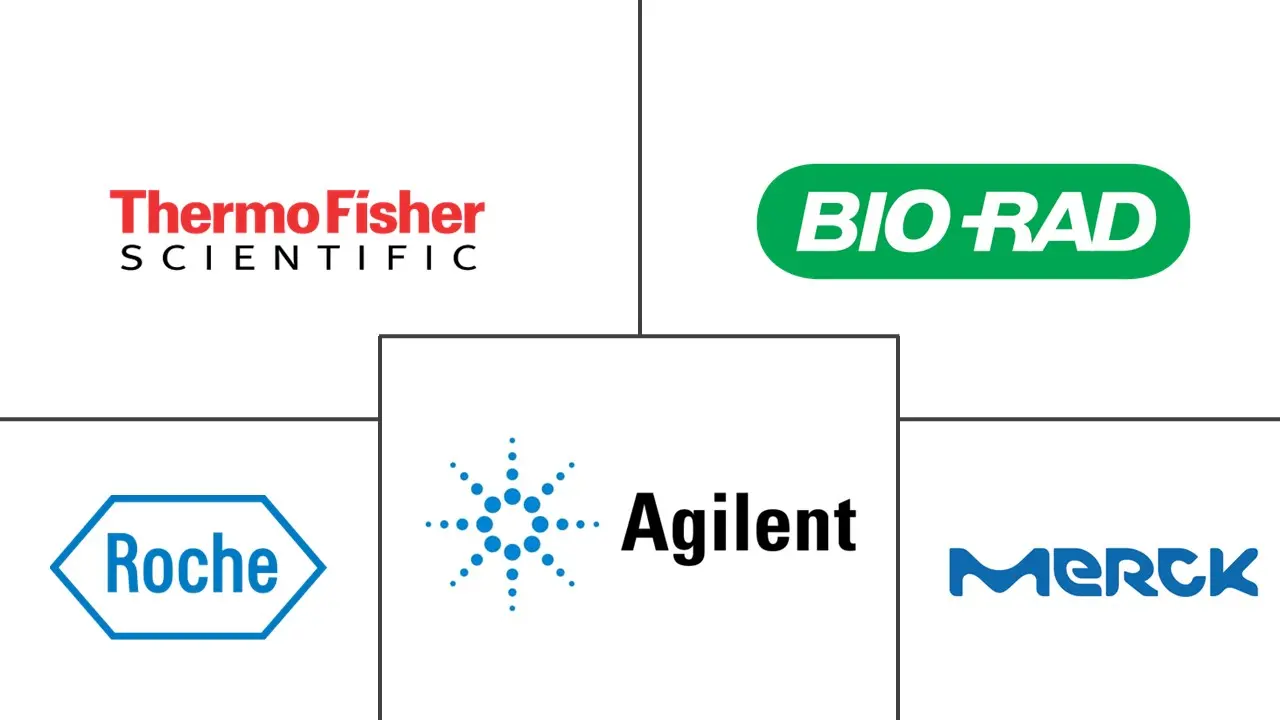qPCR Reagents Market Size and Share
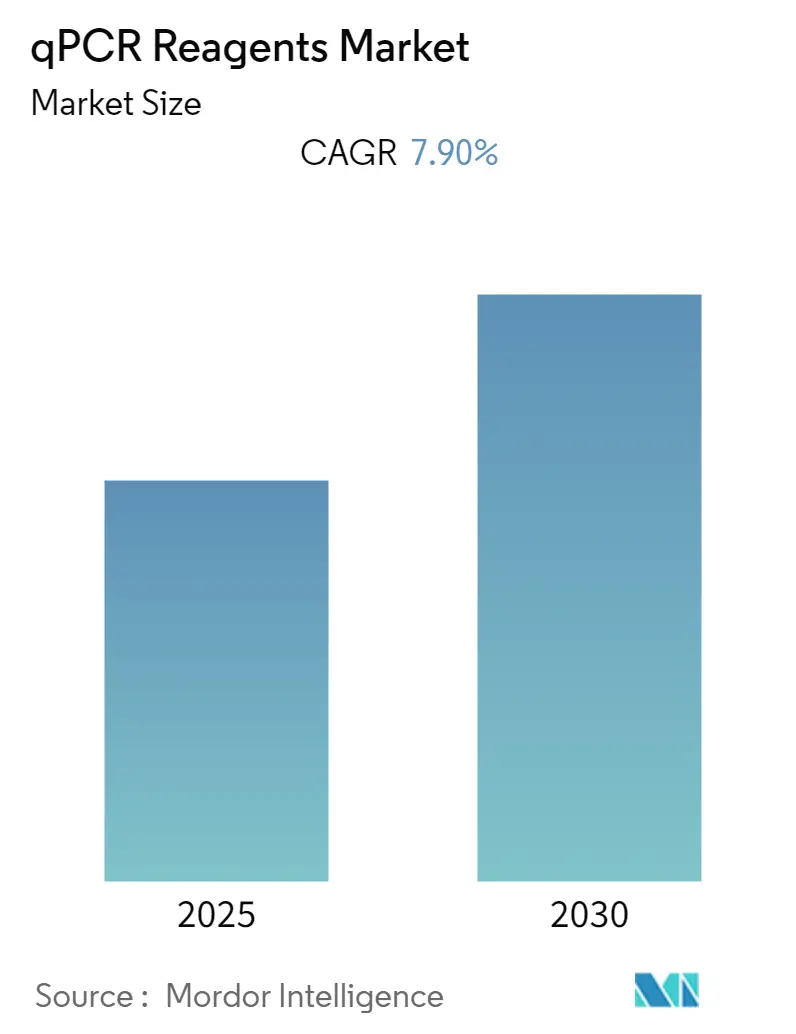
qPCR Reagents Market Analysis by Mordor Intelligence
The qPCR Reagents Market is expected to register a CAGR of 7.9% during the forecast period.
The market for qPCR reagent products has increased as a result of COVID-19, owing mostly to rising demand for polymerase chain reaction tests and a significant increase in the target patient group. The qPCR test, which uses nasopharyngeal swabs or other upper respiratory tract specimens, such as throat swabs or, more recently, saliva for immunology assays, has been the most commonly used and reliable test for COVID-19 diagnosis. As a result, disease diagnosis utilizing qPCR reagents emerged as a primary emphasis for pandemic management. The press release by Cytiva in May 2021 revealed that a qPCR reagent manufacturing company had to immediately raise output 50-fold to satisfy the demand for COVID-19 tests. Thus, during the pandemic, the demand for qPCR reagents tremendously increased, which positively influenced the market's growth. Currently, the market demand has slowed down as the number of COVID-19 has declined. Moreover, it is expected that the market will grow over the forecast period due to the rise in the prevalence of chronic diseases and technological advances in the qPCR test.
The rising incidence of infectious and genetic diseases has increased the demand for diagnostic tests that may help people take precautionary measures. The growing geriatric population has also increased the demand for genetic tests. For instance, according to the Breast Cancer Factsheet Now 2021, around 55,000 women and 370 men in the United Kingdom are diagnosed with breast cancer yearly. Breast cancer has claimed the lives of an estimated 600,000 people in the United Kingdom. This figure is expected to climb to 1.2 million by 2030. Additionally, according to the Australian Federation of AIDS Organizations Report published in November 2022, in 2021, it was estimated that there were 29,460 people with HIV in Australia. Of these 29,460 people, an estimated 91% will have been diagnosed by the end of 2021. Thus, with the growing prevalence of infectious diseases, the demand for diagnostic tests is expected to increase, which propels the growth of the market over the forecast period.
Moreover, the growing geriatric population is expected to support market expansion as this population is more susceptible to infectious and chronic diseases. The increasing geriatric population is likely to increase market growth over the forecast period. For instance, according to the 2022 statistics published by the United Nations Population Fund, in the United States, a large proportion of the living population is aged 15-64 and accounts for 65% in 2022. Furthermore, according to the same source, 17% of the population will be 65 or older in 2022. Thus, infectious diseases are more prevalent in the geriatric population, boosting the demand for qPCR reagents.
Thus, the growing burden of infectious diseases and the ageing population support market expansion over the forecast period. However, the high cost of qPCR equipment and the lack of high technical expertise to operate qPCR equipment have been restraining market growth.
Global qPCR Reagents Market Trends and Insights
Dye-Based qPCR Reagents are Expected to Dominate the Market
The use of fluorescent DNA-binding dyes is one of the most straightforward and common qPCR approaches used by scientists. A dye is added to the reaction, and fluorescence is measured at each PCR cycle. Because the fluorescence of these dyes increases dramatically in the presence of double-stranded DNA, DNA synthesis can be monitored as an increase in fluorescent signal.
Dye-based diagnostic qualitative PCR is applied to rapidly detect nucleic acids that are diagnostic of, for example, infectious diseases, cancer, and genetic abnormalities. For instance, according to the Breast Cancer Factsheet Now 2021, around 55,000 women and 370 men in the United Kingdom are diagnosed with breast cancer yearly. Breast cancer has claimed the lives of an estimated 600,000 people in the United Kingdom. This figure is expected to climb to 1.2 million by 2030. Thus, the growing burden of cancer diseases is expected to propel the segment's growth.
Additionally, product launches by the market players are expected to support the market expansion over the forecast period. For instance, in December 2021, Biotium released 'EvaRuby' Dye for qPCR and HRM. This spectrally unique red fluorescent intercalating dye can be incorporated into probe-based qPCR assays, expanding multiplexing options for probe-based qPCR. EvaRuby Dye is compatible with ~470 nm excitation and ~610 nm emission filters.
Thus, all aforementioned factors with product launches are expected to boost segment growth over the forecast period.
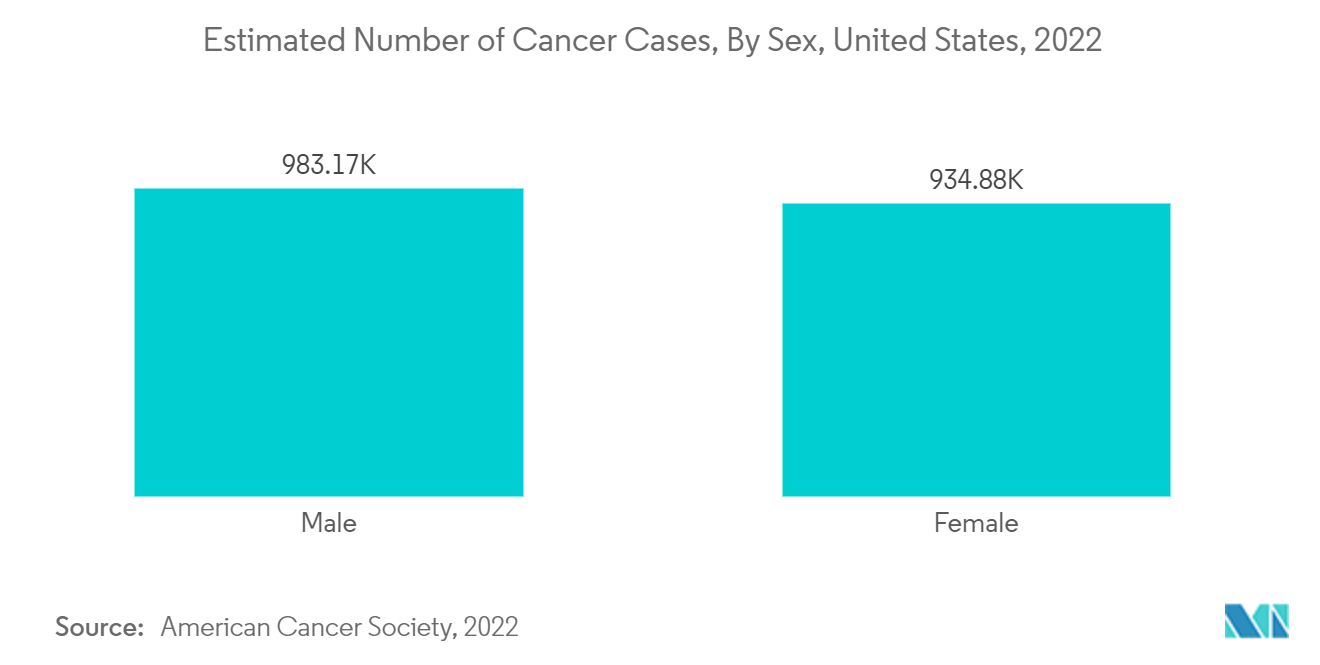
North America is Expected to Hold a Significant Market Share Over the Forecast Period
North America holds the major market share in the PCR reagent market. The rising incidence of diseases, the elderly population (aging), and technological advancements are attributed to market growth. Especially in recent times, pandemics have also boosted the qPCR reagent market. For instance, according to Cancer Facts and Figures 2022, published in January 2022 by the American Cancer Society, an estimated 1.9 million new cancer cases will be diagnosed in 2022, among which prostate cancer is estimated to be 186,670, followed by 169,870 cases of lung cancer, and 144,490 cases of female breast cancer. The increased prevalence of cancer and the high burden of other chronic diseases increase the demand for accurate diagnosis and treatment. This is likely to increase the qPCR reagent, ultimately boosting the market growth.
Furthermore, according to statistics published by the Government of Canada and released in November 2021, about 229,200 Canadians were diagnosed with cancer in 2021, and prostate cancer is expected to remain the most diagnosed cancer, accounting for 46% of all cancer diagnoses in 2021. According to the same source, breast cancer affects one out of every eight women at some point in their lives. Thus, as the number of cancer cases rises, so does the demand for early diagnosis, driving demand for qPCR reagents over the projection period.
Additionally, product launches by the market players are expected to support market growth. For instance, in February 2022, New England Biolabs (NEB) released the LyoPrime Luna Probe One-Step RT-qPCR Mix with UDG, its first lyophilized product manufactured by Fluorogenics. This lyophilized master mix has the same adaptable characteristics and strong performance as the previously published liquid 4X mix, allowing for sensitive, linear real-time detection of target RNA sequences in a room temperature-stable format.
Thus, all aforementioned factors, such as the growing burden of infectious diseases, are expected to boost the growth of the market in the region.
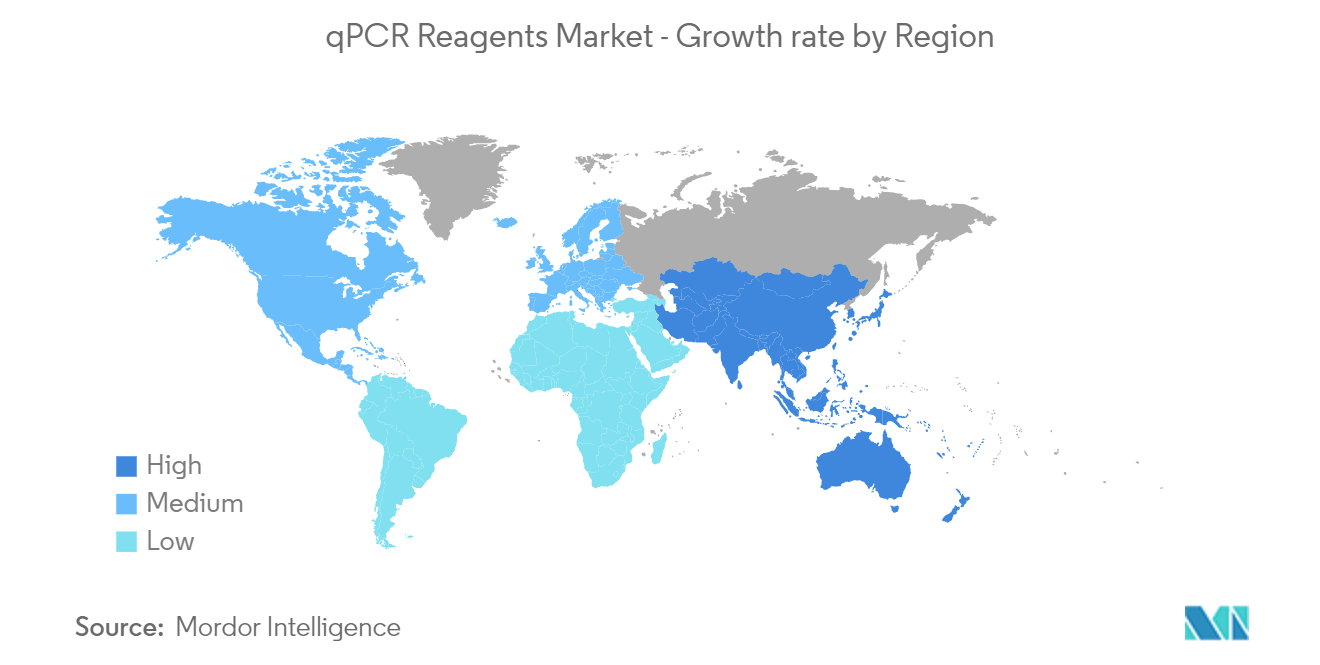
Competitive Landscape
The qPCR reagents market is highly competitive and consists of a few major players. Market leaders with more funds for research and better distribution system have established their position in the market. The key Companies in this market are F. Hoffman-La Roche Ltd, Agilent Technologies, Bio-Rad Laboratories Inc, Merck KGaA (Sigma Aldrich Corporation), and Thermo Fisher Scientific Inc.
qPCR Reagents Industry Leaders
-
F. Hoffman-La Roche Ltd
-
Bio-Rad Laboratories Inc
-
Sigma-Aldrich Corporation (Merck Kgaa)
-
Thermo Fisher Scientific Inc
-
Agilent Technologies Inc.
- *Disclaimer: Major Players sorted in no particular order
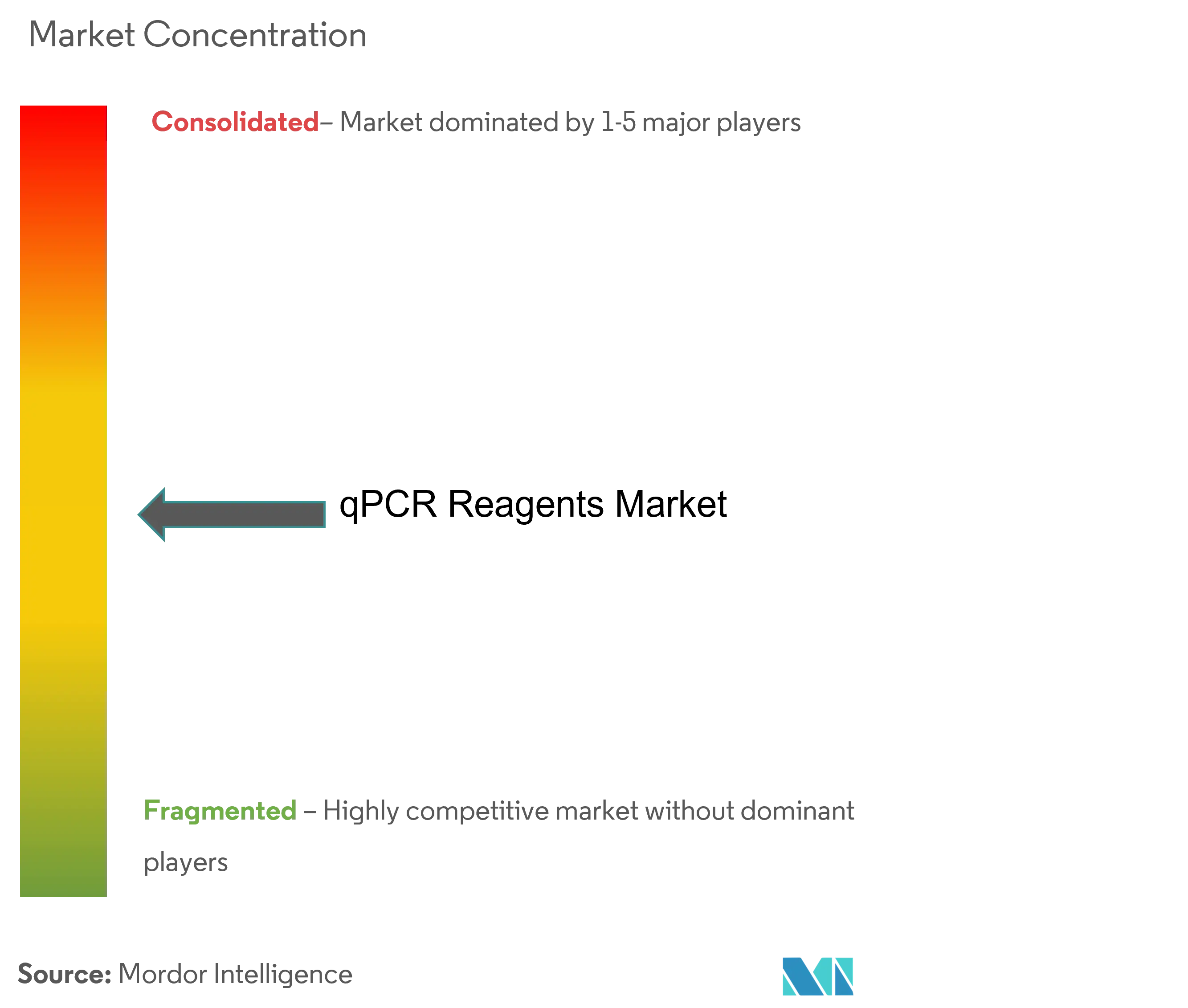
Recent Industry Developments
- November 2022: PCR Biosystems launched a new family of qPCR reagent mixes: Clara Probe Mix, Clara Probe 1-Step Mix, and Clara HRM Mix. The cutting-edge Clara family of mixes relies on a novel composition to push the boundaries of performance to meet the challenges of laboratories.
- September 2022: Integrated DNA Technologies introduced a new PrimeTime qPCR One-Step Master Mix including an exclusive mutant enzyme. This master mix's unique, patented mixture is perfect for viral research and other gene expression applications, and it comes in a 4X concentrated formulation that removes the need for an extraction step.
Global qPCR Reagents Market Report Scope
As per the scope of the report, a real-time polymerase chain reaction (real-time PCR) or quantitative polymerase chain reaction (qPCR) is a laboratory technique of molecular biology based on the polymerase chain reaction (PCR). It monitors the amplification of a targeted DNA molecule during the PCR. The qPCR Reagents Market is segmented by Detection Method (Dye-Based qPCR Reagents, Probes, and Primer-Based qPCR Reagents), Packaging Type (qPCR Core Kits, and qPCR Mastermixes), End-User (Hospitals & Diagnostic Centers, Research Laboratories & Academic Institutes, and Others), and Geography (North America, Europe, Asia-Pacific, Middle East, and Africa, and South America). The market report also covers the estimated market sizes and trends for 17 different countries across major regions globally. The report offers the value in USD (US Dollar) million for the above segments.
| Dye-Based qPCR Reagents |
| Probes and Primer-Based qPCR Reagents |
| qPCR Core Kits |
| qPCR Mastermixes |
| Hospitals & Diagnostic Centers |
| Research Laboratories & Academic Institutes |
| Others |
| North America | United States |
| Canada | |
| Mexico | |
| Europe | Germany |
| United Kingdom | |
| France | |
| Italy | |
| Spain | |
| Rest of Europe | |
| Asia-Pacific | China |
| Japan | |
| India | |
| Australia | |
| South Korea | |
| Rest of Asia-Pacific | |
| Middle-East and Africa | GCC |
| South Africa | |
| Rest of Middle-East and Africa | |
| South America | Brazil |
| Argentina | |
| Rest of South America |
| By Detection Method | Dye-Based qPCR Reagents | |
| Probes and Primer-Based qPCR Reagents | ||
| By Packaging Type | qPCR Core Kits | |
| qPCR Mastermixes | ||
| By End-User | Hospitals & Diagnostic Centers | |
| Research Laboratories & Academic Institutes | ||
| Others | ||
| Geography | North America | United States |
| Canada | ||
| Mexico | ||
| Europe | Germany | |
| United Kingdom | ||
| France | ||
| Italy | ||
| Spain | ||
| Rest of Europe | ||
| Asia-Pacific | China | |
| Japan | ||
| India | ||
| Australia | ||
| South Korea | ||
| Rest of Asia-Pacific | ||
| Middle-East and Africa | GCC | |
| South Africa | ||
| Rest of Middle-East and Africa | ||
| South America | Brazil | |
| Argentina | ||
| Rest of South America | ||
Key Questions Answered in the Report
What is the current qPCR Reagents Market size?
The qPCR Reagents Market is projected to register a CAGR of 7.9% during the forecast period (2025-2030)
Who are the key players in qPCR Reagents Market?
F. Hoffman-La Roche Ltd, Bio-Rad Laboratories Inc, Sigma-Aldrich Corporation (Merck Kgaa), Thermo Fisher Scientific Inc and Agilent Technologies Inc. are the major companies operating in the qPCR Reagents Market.
Which is the fastest growing region in qPCR Reagents Market?
Asia-Pacific is estimated to grow at the highest CAGR over the forecast period (2025-2030).
Which region has the biggest share in qPCR Reagents Market?
In 2025, the North America accounts for the largest market share in qPCR Reagents Market.
What years does this qPCR Reagents Market cover?
The report covers the qPCR Reagents Market historical market size for years: 2021, 2022, 2023 and 2024. The report also forecasts the qPCR Reagents Market size for years: 2025, 2026, 2027, 2028, 2029 and 2030.
Page last updated on:
qPCR Reagents Market Report
Statistics for the 2025 qPCR Reagents market share, size and revenue growth rate, created by Mordor Intelligence™ Industry Reports. qPCR Reagents analysis includes a market forecast outlook for 2025 to 2030 and historical overview. Get a sample of this industry analysis as a free report PDF download.
